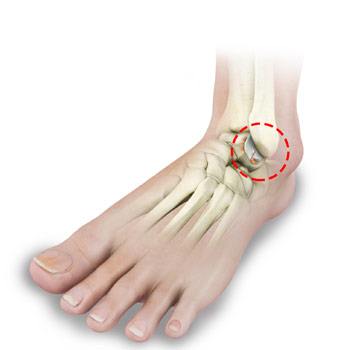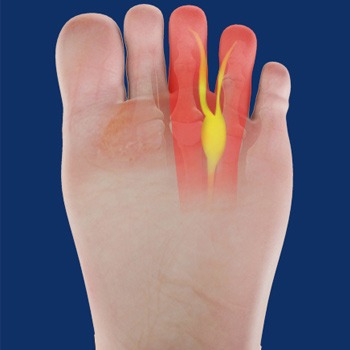- Anatomy
- Conditions
- Procedures
Foot and Ankle Fractures
Foot fracture is a condition where there are small cracks in the bones. It occurs because of a fall, motor vehicle accident, dropping a heavy object on your foot or from overuse with sports. The trauma or repeated stress on the foot often results in pain, swelling, deformity and inability to bear weight. Ankle fracture is a condition where there is a break in one or more bones forming the ankle joint. It occurs from excessive rolling and twisting of the ankle often resulting in swelling, severe pain around the ankle and impaired mobility. Click on the below tabs to learn more about the various types of foot and ankle fractures.
Bunion
A bunion is a bony protuberance that appears on the outer surface of the big toe when it angles toward the adjacent toe. It is an extra bone and a fluid-filled sac that grows at the base of the big toe.
Foot and Ankle Arthritis
Arthritis is the inflammation of joints as a result of degeneration of the smooth cartilage that lines the ends of bones in a joint. This degeneration of the cartilages leads to painful rubbing of the bones, swelling, and stiffness in the joints, resulting in restricted movements. Arthritis in the foot and ankle can occur due to fractures, dislocation, inflammatory disease, or congenital deformity.
Achilles Tendinitis
The Achilles tendon is a tough band of fibrous tissue that runs down the back of your lower leg and connects your calf muscle to your heel bone. The tendon is used when you walk, climb, jump, run and stand on your tip toes.
Achilles Tendon Rupture
The Achilles tendon is a strong fibrous cord present behind the ankle that connects the calf muscles to the heel bone. It is used when you walk, run and jump. The Achilles tendon ruptures most often in athletes participating in sports that involve running, pivoting and jumping. Recreational sports that may cause Achilles rupture include tennis, football, basketball, and gymnastics.
Lisfranc (Midfoot) Injury
The tarsometatarsal joint or Lisfranc joint is the region in the middle of the foot formed by the articulation of the tarsal bones (a cluster of seven bones) and metatarsal bones (a group of five long bones). This region supports the arch of the foot. Lisfranc or midfoot fractures are breaks in the bones of the midfoot. They also involve torn ligaments that support the midfoot. The injury can be simple or complex, involving many bones and joints of the midfoot. A Lisfranc injury is sometimes mistaken for a sprain in the foot when you twist your leg and fall.
Cavus Foot Deformity
Cavus foot also referred to as a high arch, is a condition in which the arch on the bottom of the foot that runs from the toes to the heel is arched more than normal. Because of this, excessive weight falls on the ball and heel of the foot when walking or standing, causing pain and instability. Children with neurological disorders or other conditions such as cerebral palsy, spina bifida, poliomyelitis, and muscular dystrophy are more likely to develop Cavus foot. It may sometimes occur as an inherited abnormality.
Bunionette
Bunionette also referred to as a tailor’s bunion is a bony lump that grows on the outside of the foot at the base of your little toe. The deformity got its name as q tailor’s bunion when tailors once sat with their legs crossed all day, with the outside edge of their feet rubbing on the ground. This constant rubbing gave rise to a painful bump at the base of their little toe. A bunionette differs from a bunion which typically develops on the inside of the foot below the big toe.
Haglunds Deformity
Haglund’s deformity, also known as “pump bump”, is a condition in which bony extensions are formed at the back of the heel, leading to swelling near the Achilles tendon. Due to the bony enlargement, the tissue near the Achilles tendon becomes irritated when it rubs against footwear, causing painful bursitis.
Peroneal Tendon Dislocation
The peroneal tendons run behind the lateral malleolus (the bony protrusion on the outside of the ankle). They connect the peroneal muscles - the peroneus brevis and peroneus longus - to the foot. Peroneal tendon dislocation occurs when either of the tendons slips forward over the lateral malleolus due to a tear in the tendon near its attachment to the bone. When this occurs frequently it can result in inflammation of the tendon causing pain and limiting movement.
Ankle Sprain
A sprain is the stretching or tearing of ligaments. Ligaments connect adjacent bones and provide stability to a joint. An ankle sprain is a common injury that occurs when you suddenly fall or twist the ankle joint, or when you land your foot in an awkward position after a jump. Most commonly, it occurs when you participate in sports, or jump or run on a surface that is irregular.
Ankle Instability
The joints of the ankle are held in place and stabilized by strong bands of tissue called ligaments. Ankle instability is a chronic condition characterized by a recurrent slipping of the outer side of the ankle. It usually results from repeated ankle sprains, which are injuries to the ligaments. Ankle instability is generally noticed when you move your ankle joint but can also occur while standing.
Lisfranc (Midfoot) Fracture
The Lisfranc joint or tarsometatarsal joint refers to the region in the middle of the foot. It is a junction between the tarsal bones (bones in the foot arch) and metatarsal bones (five long bones in the foot). Lisfranc fractures can occur due to a fall from a height or a traumatic motor vehicle accident.
Turf Toe
Turf toe is an injury to the ligament at the base of the big toe. It is a painful condition that usually results from jamming the toe into the ground or excessive backward bending of the toe. As it is more common in athletes playing on artificial turf, especially those involved in field sports such as football, baseball, and soccer, it is known as turf toe.
Morton's Neuroma
Morton’s neuroma refers to a nerve injury that occurs between the toes, usually the third and fourth toes. This causes pain and thickening of the nerve tissue.
Flatfoot
Flatfoot, also known as “fallen arches” or Pes planus, is a deformity in children’s feet where the arch that runs along the sole of the foot collapses to the ground or is not formed at all. Flatfoot is normal in the first few years of life as the arch of the foot usually develops between the age of 3 and 5 years.
Peroneal Tendonitis
Peroneal tendonitis is inflammation of the peroneal tendons in the ankle due to an acute or overuse injury. It is common in those participating in sports involving repeated ankle movement such as running.
Osteochondral Lesions of the Ankle
The tibia and the fibula bones of the lower leg join with the talus bone to form the ankle joint. The talus bone is an important bone located between the tibia and fibula and the heel bone (calcaneus). OCL or OCD is the damage to the cartilage and the talus bone of the ankle joint. Usually, the inner or the medial portion of the ankle is affected.
Stiff Big Toe (Hallux Rigidus)
A stiff big toe, also called hallux rigidus, is a form of degenerative arthritis affecting the joint where the big toe (hallux) attaches to the foot. The toe typically becomes stiff at the base and is sometimes called a “frozen joint”.
Tarsal Coalition
Tarsal coalition is a foot disorder that occurs due to an abnormal connection between two or more tarsal bones. These bones are located at the back of the foot and in the heel. Basically, with this condition, the bones tend to grow within one another and are joined together with the help of surrounding bones and cartilage. Tarsal coalition may result in severe flatfoot. It is usually inherited and remains asymptomatic until the child grows and enters early adolescence. The foot may become stiff and painful, and daily physical activities can become challenging. If left untreated, tarsal coalition may progress into foot arthritis.
























